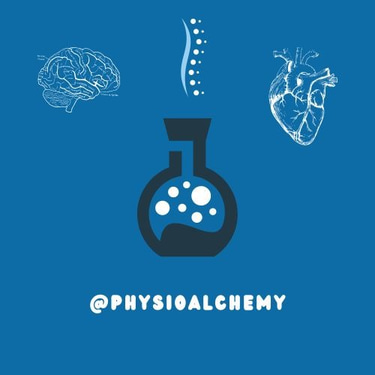The Role of Diaphragmatic Training in Chronic Pain and Posture Correction
STUDY MATERIAL
PhysioAlchemy
7/28/2025
Introduction
The diaphragm, traditionally regarded as a respiratory muscle, plays a multifaceted role that extends beyond ventilation. Recent evidence has highlighted its significance in postural stability, spinal support, and modulation of chronic pain. Dysfunction in diaphragmatic mechanics can lead to compensatory movement patterns, reduced intra-abdominal pressure (IAP), altered postural alignment, and heightened sympathetic nervous system activity all of which contribute to the persistence of chronic musculoskeletal pain.
This article explores the clinical relevance of diaphragmatic training as a therapeutic intervention in patients with chronic pain and postural abnormalities, with an emphasis on its neuromechanical, postural, and biopsychosocial implications.
Anatomical and Functional Overview of the Diaphragm
The diaphragm is a dome-shaped musculotendinous structure that separates the thoracic and abdominal cavities. It originates from the xiphoid process, lower six ribs, and lumbar vertebrae (via the crura), and inserts centrally into the diaphragmatic tendon.
While its primary function is respiratory facilitating inspiration through contraction and descent—it also plays a critical role in:
Generating intra-abdominal pressure (IAP) for spinal stabilization,
Coordinating with the pelvic floor, multifidus, and transversus abdominis to maintain core integrity,
Contributing to circulatory and lymphatic return via mechanical pressure gradients.
Dysfunction of the diaphragm due to pain, poor posture, or habitual upper chest breathing can compromise all of these functions.
Diaphragmatic Dysfunction and Chronic Pain
Chronic musculoskeletal pain conditions, particularly in the cervical and lumbar regions, are frequently associated with altered breathing mechanics. Patients with low back pain often exhibit:
Shallow, thoracic-dominant breathing patterns,
Reduced diaphragmatic excursion,
Impaired generation of IAP,
Increased recruitment of accessory muscles (e.g., sternocleidomastoid, scalenes),
Altered trunk muscle synergy.
These adaptations not only decrease spinal stability but perpetuate inefficient motor control and proprioception. Several studies have reported reduced diaphragm thickness and contractility in individuals with chronic low back pain, suggesting a direct impairment in muscle function.
The dysfunctional breathing patterns contribute to heightened sympathetic activity, further amplifying pain perception and perpetuating the pain cycle.
Postural Implications of Diaphragmatic Control
Postural control is a dynamic interaction between the musculoskeletal and neuromotor systems. The diaphragm contributes to this system by modulating intra-thoracic and intra-abdominal pressures, which are essential for:
Segmental spinal stabilization,
Load transfer during functional tasks,
Maintaining center-of-mass alignment.
An impaired diaphragm compromises this balance, leading to compensatory postural strategies such as:
Rib flaring or splaying,
Hyperextension at the thoracolumbar junction,
Forward head posture,
Altered pelvic positioning (e.g., anterior pelvic tilt).
Over time, these deviations result in muscle imbalances, joint overload, and inefficient movement patterns, contributing to or exacerbating chronic pain.
Neurophysiological Perspective: The Breath–Pain Connection
The diaphragm has bidirectional connections with the autonomic nervous system via the phrenic and vagus nerves. Diaphragmatic breathing activates parasympathetic pathways, particularly the vagal tone, which is associated with:
Reduced heart rate and blood pressure,
Improved heart rate variability (HRV),
Downregulation of the hypothalamic–pituitary–adrenal (HPA) axis.
This autonomic shift contributes to central pain modulation, emotional regulation, and decreased cortical arousal critical components in managing chronic pain within a biopsychosocial framework.
Evidence supports that diaphragmatic training can lead to improvements not only in pain intensity but also in quality of life, sleep quality, and anxiety reduction, particularly in patients with chronic low back pain and fibromyalgia.
Clinical Application: Diaphragmatic Training Protocols
Assessment Tools:
Observation and palpation of breathing patterns (e.g., Hi-Lo Test),
Ultrasound imaging for diaphragm thickness and excursion,
Respiratory pattern assessment in various positions.
Training Progression:
Supine Position: Begin in a gravity-eliminated position to teach diaphragmatic excursion. Use tactile cues at the lower rib cage and abdomen to facilitate correct activation.
Load Integration: Add a small weight (e.g., 0.5–1 kg) over the abdomen to provide proprioceptive feedback.
Functional Positioning: Progress to seated, quadruped, and standing positions to integrate diaphragmatic activation with posture.
Dynamic Integration: Incorporate diaphragmatic control during functional tasks (e.g., sit-to-stand, squatting, walking) and core stability exercises.
Biofeedback and IMT Devices: Use tools such as inspiratory muscle trainers (e.g., PowerBreathe, Threshold IMT) to strengthen the diaphragm and promote motor relearning.
Combined Approach: Diaphragmatic training should be integrated with pelvic floor retraining, transversus abdominis activation, and spinal proprioceptive exercises to maximize its postural and analgesic benefits.
Indications and Target Populations
Diaphragmatic training is indicated in various clinical scenarios, including:
Chronic non-specific low back pain,
Mechanical neck pain and cervicogenic headache,
Postural disorders (e.g., scoliosis, kyphosis),
Post-surgical rehabilitation (CABG, thoracic surgeries),
Autonomic dysfunction and anxiety-related somatic complaints,
Respiratory conditions with altered mechanics (e.g., COPD).
Conclusion
Diaphragmatic training is a clinically valuable intervention that addresses both the mechanical and neurophysiological dimensions of chronic pain and postural control. It offers a low-cost, non-invasive strategy that enhances core stability, optimizes breathing mechanics, and contributes to central pain modulation.
Incorporating diaphragmatic assessment and training into physiotherapy practice represents a shift toward holistic, integrated rehabilitation one that recognizes the diaphragm not only as a respiratory muscle but as a cornerstone of movement, stability, and recovery.
Think Anatomically. Treat Clinically.
Our Socials:
© 2025 PhysioAlchemy. All rights reserved.
Legal:
Made with ♥ by physiotherapists, for physiotherapists.
Subscribe to our newsletter:
Enjoy exclusive special deals available only to our subscribers.
